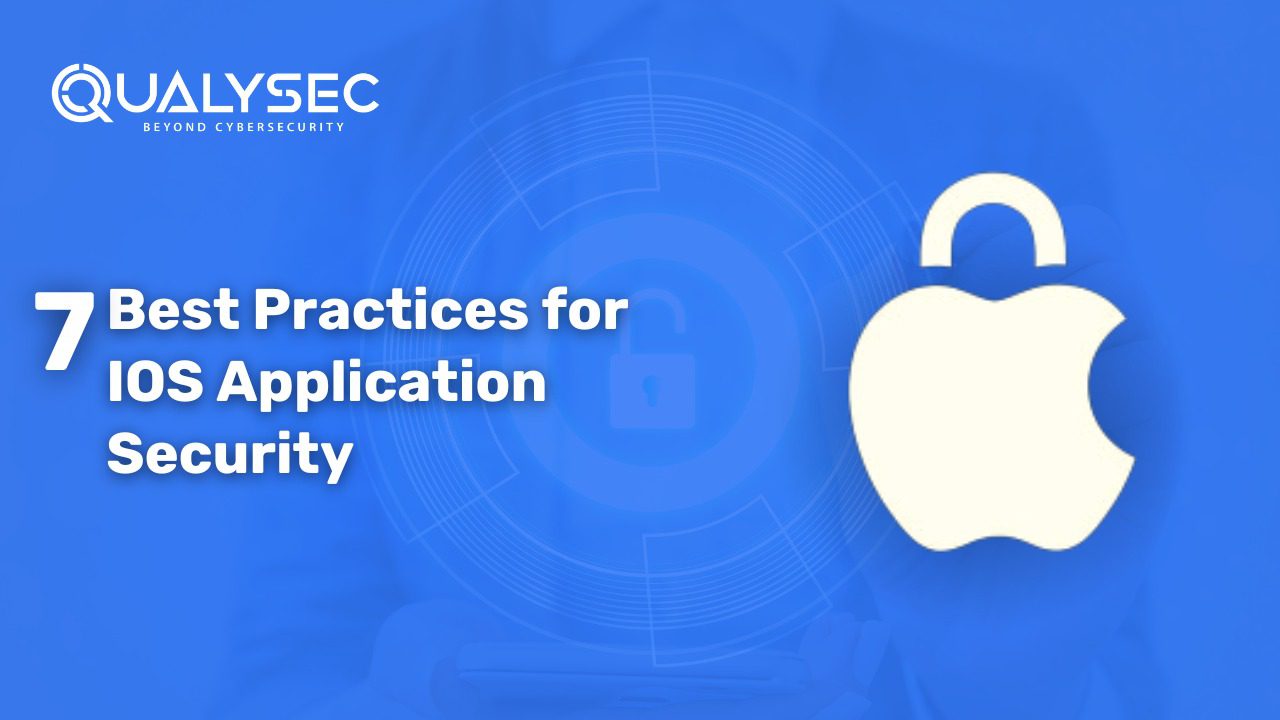© 2024 Qualysec.com Disclaimer Privacy Policy Terms & Conditions

Nowadays, we use our Mac and iOS devices for nearly everything, from sending an email to transferring money. Because these actions are carried out over the internet, you are vulnerable to potential security breaches.
You must accept that iOS application security threats will always exist, and you will never be able to make your product completely safe. What you can do is mitigate and limit those risks as much as possible.
You should strive to make your mobile application as safe as feasible as a mobile developer. Assume you’re developing an application for a financial institution. What happens to your client’s reputation if there is a security breach?
What about your client’s clients? Consider someone stealing money by exploiting an avoidable security flaw. Let’s go over some ways you may use right away to make your mobile applications a little more secure.
iOS and iPadOS, unlike other mobile systems, do not enable users to install potentially harmful unsigned programs from websites or execute untrusted apps. Still, fast growth in app development has resulted in great convenience, but it also exposes new security concerns. iOS app security testing is no longer a luxury, but a need.
The common threats, such as malicious software, insufficient data security, and unexpected money transactions, highlight the critical necessity to implement safety measures. Nonetheless, due to the emphasis on user experience and functionality, app developers routinely overlook security measures.
Click here to learn more about Mobile Application Security
Strong iOS application security testing becomes increasingly important as data theft and breaches grow more common in a world of digital progress. Passwords, profiles, credit card details, and other sensitive data are often end users access. Furthermore, a breach can have dire implications, ranging from financial loss to destroyed credibility.
As a result, developers must prioritize iOS app security as both a requirement and a responsibility. It is not only about keeping data safe but also about maintaining user confidence and following privacy rules.
A robust encryption system ensures the security of all communication and material, while face recognition and fingerprint authentication inspire trust in users. Furthermore, applications must adhere to global data governance rules in order to maintain corporate integrity and promote brand reputation.
Are you looking for a penetration testing service provider to help you with your iOS app penetration testing? Don’t be concerned! Please contact our specialists immediately for a free consultation. We will assist you in identifying and addressing any vulnerabilities in your corporate infrastructure.
What are the Common Cyber Threats in iOS Applications?
Common iOS vulnerabilities include a wide range of concerns. Remote code execution, privilege escalation, data breaches, application-specific vulnerability, and man-in-the-middle attacks are some of the more prevalent ones that have lately become significant. Let’s go over them one by one.
In iOS, remote code execution allows attackers to remotely run malicious code and gain control of devices. Furthermore, this sort of attack can be carried out without the victim’s knowledge, potentially obtaining unauthorized access to the system, stealing data, or leveraging the device’s resources for malevolent purposes.
How to Mitigate:
When sensitive information is mistakenly exposed or purposely stolen from a system, it can lead to unauthorized access and abuse of personal, financial, or corporate information. It can occur for a variety of reasons, including security breaches, software flaws, or data transmission across separate systems.
How to Mitigate:
App vulnerabilities are defects or weaknesses in a mobile application that hackers might exploit to carry out unwanted acts such as data theft, malware injection, or app functionality disruption. These flaws might result from poor coding standards, a failure to update software, or a lack of adequately secure data within the app.
How to mitigate:
An attacker might try to get into your app by providing it with odd data that allows unauthorized access. That data is frequently altered in such a way that it may be interpreted by your program as executable code. For instance, SQL injection is just one type of client-side injection.
How to mitigate:
An attacker can easily intercept data as it passes via Wi-Fi or a mobile device’s carrier network. While data in transit is frequently encrypted, it is also frequently misconfigured, or the keys are managed incorrectly, or the developers utilize a customer encryption technique that is less secure than recent algorithms.
How to Mitigate:
Click here to learn more about Vulnerable iOS Application for Testing
iOS developers and security teams should be aware of many best practices from the beginning of app development to ensure the delivery of safe and resilient applications.
iOS app pentesting and upgrading your app regularly are two methods that aid in the security of iOS apps by finding and correcting any security vulnerabilities or problems that may develop. Penetration Testing is the process of examining your software for faults, defects, or vulnerabilities that might jeopardize its functioning or security. Furthermore, you may use a variety of tools and services to test and update your app regularly.
Want to see how a detailed report can ensure the security of your iOS application? Download a copy of our sample report here!
(ADD DOWNLOAD SAMPLE REPORT)
2. Use Secure Communication Protocols
Instead of HTTP, use secure communication protocols like HTTPS to send data over the network. HTTPS encrypts data as it travels, making it hard for attackers to intercept and read it. Furthermore, always check the server certificate to guarantee that no man-in-the-middle attackers are interfering with the transmission.
Adding two-factor authentication to your iOS app may provide additional security. It adds an extra step to the login process, making attackers’ access to user accounts more difficult. A password can be combined with a second factor such as a fingerprint, face ID, or a one-time code sent to the user’s registered cellphone number or email address.
The first line of protection against unwanted access is user authentication. To improve user account security, utilize strong authentication techniques such as two-factor (2FA) or multi-factor (MFA). Use suitable authorization controls to limit access depending on user roles and permissions.
iOS devices support digitally signed programs with verified certificates, such as those supplied to developers by Apple. Jailbroken devices can circumvent these and other security measures. It allows the execution of unapproved and potentially dangerous apps, compromising critical corporate data. Furthermore, this danger can be reduced by setting a rule that prevents this process on controlled devices.
iOS applications can share data via system APIs if they are segregated from each other in sandboxes. It signifies that unsecured corporate data may be in danger, such as an enterprise program that allows file access with a third-party application. Furthermore, developers may elect to restrict the usage of specific terminal or device characteristics. In brief, it is not only about protecting data at rest but also about where data can travel and how to prevent it from migrating.
Take into account the device’s security. Encourage consumers to use strong passcodes or biometric authentication (Touch ID or Face ID) to secure their data in the event that their smartphone is stolen. Allow data erasure after several failed login attempts and avoid retaining sensitive data in device logs or temporary storage.
Security testing may detect flaws in a system and safeguard data and resources against assault. It simulates a cyberattack on the environment in order to identify any existing weaknesses. Here are some of the most important reasons:
Maintaining firm ethics and protecting its reputation is critical. Brand loyalty is an important aspect of doing this. iOS penetration testing is specifically built for this purpose. It is a form of mobile app security assessment in which testers design a remote attack using their extensive IT expertise and specialized tools. They get access to the client’s environment without consent or required permissions.
For starters, security testing is required for ISO 27001 certification, HIPAA compliance, and OWASP methodology. Cybersecurity laws need this. Furthermore, severe fines are included in regulatory standards and compliance obligations if the regulations are breached. Adherence to these laws is critical to maintaining perfect security. Gaining trust in the customer-enterprise connection may go a long way.
By removing vulnerabilities from the application interface, iOS security testing reduces risks. Cybercriminals can detect and exploit systemic faults in your system. In addition, it is feasible to forecast the behavior of a malicious source using effective testing procedures; this skill prepares businesses for future risk scenarios. You may uncover problems in your code and remedy them by estimating the behavior of hackers.
Related Article: How is Penetration Testing for Mobile Apps Performed
A data breach may cause considerable financial harm to a company in a variety of ways. If hackers get your personal information, they may demand payment in the form of ransomware. This may be prevented if the program is subjected to vulnerability and penetration testing before release. Penetration testing iOS apps examines all security weaknesses to guarantee that it is secure from both internal and external attacks. As a result, investing in security is better than falling victim to hackers or attacks.
Learn more about the Benefits of Mobile App Penetration Testing
When deciding on pentesting iOS applications, consider how frequently you will need testing. This might range from once a year to more frequently if paired with an agile development plan.
For businesses that need to test frequently, pen testing provides a methodical method for repeating this generally tedious activity. The scope of these ongoing testing methods differs depending on the specific changes or new assets delivered.
In addition, finding a team that you can trust in the ever-changing world of application development is crucial for your organization’s safety and seamless operation. Look no further QualySec will go above and above to ensure that you have all you need for a stress-free experience.
Your application’s security is not speculative. It should be a standard practice for all firms. That is why we are committed to supporting you in incorporating security into the heart of your business. We may do a thorough security assessment as well as an evaluation to help you better understand your security.
QualySec stands out as the only Indian company that does process-based iOS pentesting. This unique strategy ensures that your apps are not only safe but also follow industry best practices. Our pentesting services offer a comprehensive approach to process-based security testing, including both automated vulnerability scanning and manual pentesting abilities.
QualySec’s competent and experienced team is more than capable of meeting the most stringent security needs. We take pride in our extensive testing knowledge, which enables us to tailor security solutions to your specific application, preferences, and industry experience.
We utilize a combination of in-house and commercial solutions to enhance your apps, such as Burp Suite and Netsparker. What sets us apart is the experience of our pen testers, who provide a plethora of knowledge and manual testing skills to ensure zero false positives. We give our clients a detailed and developer-friendly report that helps them understand the vulnerability in depth and tackle the issues in a step-by-step style that includes the location of the vulnerability detected as well as references on how to remedy the vulnerability.
Navigating the difficult landscape of compliance is not easy. We are here to assist companies in satisfying GDPR, SOC2, ISO 27001, HIPAA, and other laws. Compliance is an important element of your company’s journey, and we can help you fulfill it with our extensive penetration testing methodology and experienced remedial support.
We have a track record of securing over 250 applications in the last three years. Our global network comprises more than 100 partners from more than 20 countries, and we are proud to state that we have never had a data breach.
Are you ready to protect your application and your business? Contact us today and let QualySec be your digital shield! Your safety is our top priority.
To guarantee IOS app security, sensitive user data must be protected, privacy regulations must be followed, and user trust must be maintained. Although iOS has built-in security safeguards, developers must also follow best practices, respect user privacy, and update their apps regularly.
Finally, protecting iOS apps is a duty that has far-reaching repercussions for both businesses and users. Reach out to us for professional help and a better understanding of how to perform penetration testing and why is it necessary. Secure your business infrastructure today! Click here to fill out the form!
What is iOS application penetration testing?
The technique of detecting and exploiting vulnerabilities in iOS applications is known as iOS penetration testing. Decompiling the program to find any problems that might lead to bugs, or utilizing an automated tool to do so, could be the way.
What types of security vulnerabilities can be discovered through iOS application penetration testing?
iOS applications save sensitive user data including login passwords, personal information, and other secret information. Our iOS penetration testing guarantees that your iOS application maintains sensitive data safely and does not reveal it to unauthorized parties.
How is iOS application penetration testing different from regular application testing?
It entails studying device-specific vulnerabilities and assessing the efficiency of built-in security mechanisms, as well as analyzing the security of the application’s source code. Web app testing, on the other hand, focuses on browser-based web-based apps.
What tools are common for iOS application penetration testing?
Cybersecurity companies like QualySec have their in-house-built tools to test iOS applications, but there are commercial tools available such as Metasploit, Nmap, Nikito, W3AF, etc., to conduct iOS application testing.
What is the purpose of the iOS app?
The iPhone operating system (iOS) is built for usage with Apple’s multitouch devices. The mobile operating system accepts direct manipulation input and responds to numerous user movements including pinching, tapping, and swiping. The iOS developer kit includes tools for developing iOS apps.





Plot No:687, Near Basudev Wood Road,
Saheed Nagar, Odisha, India, 751007
No: 72, OJone India, Service Rd, LRDE Layout, Doddanekundi, India,560037
© 2024 Qualysec.com Disclaimer Privacy Policy Terms & Conditions


No: 72, OJone India, Service Rd, LRDE Layout, Doddanekundi, India,560037
© 2024 Qualysec.com Disclaimer Privacy Policy Terms & Conditions